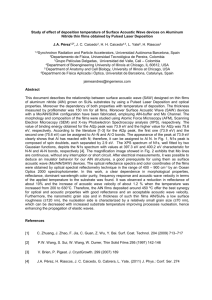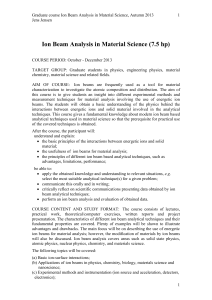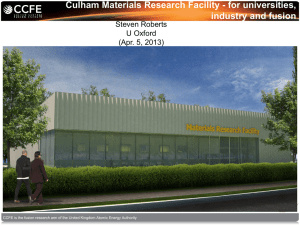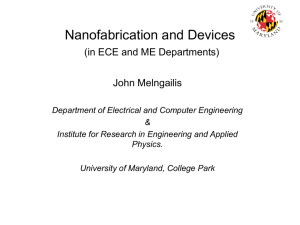References
advertisement
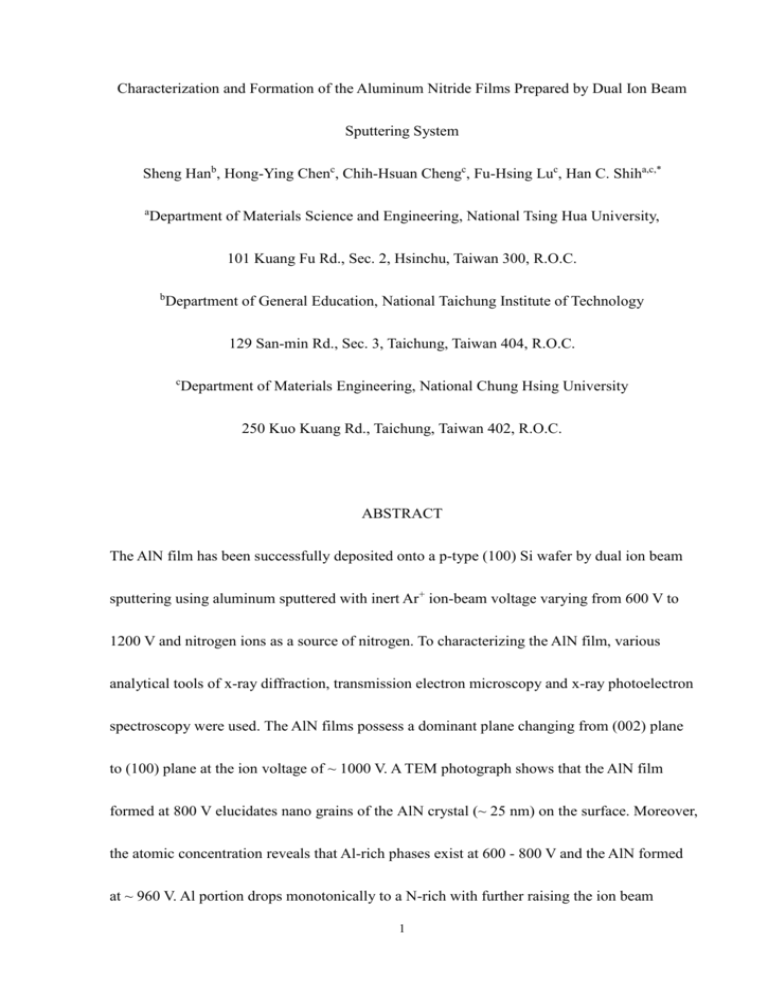
Characterization and Formation of the Aluminum Nitride Films Prepared by Dual Ion Beam Sputtering System Sheng Hanb, Hong-Ying Chenc, Chih-Hsuan Chengc, Fu-Hsing Luc, Han C. Shiha,c,* a Department of Materials Science and Engineering, National Tsing Hua University, 101 Kuang Fu Rd., Sec. 2, Hsinchu, Taiwan 300, R.O.C. b Department of General Education, National Taichung Institute of Technology 129 San-min Rd., Sec. 3, Taichung, Taiwan 404, R.O.C. c Department of Materials Engineering, National Chung Hsing University 250 Kuo Kuang Rd., Taichung, Taiwan 402, R.O.C. ABSTRACT The AlN film has been successfully deposited onto a p-type (100) Si wafer by dual ion beam sputtering using aluminum sputtered with inert Ar+ ion-beam voltage varying from 600 V to 1200 V and nitrogen ions as a source of nitrogen. To characterizing the AlN film, various analytical tools of x-ray diffraction, transmission electron microscopy and x-ray photoelectron spectroscopy were used. The AlN films possess a dominant plane changing from (002) plane to (100) plane at the ion voltage of ~ 1000 V. A TEM photograph shows that the AlN film formed at 800 V elucidates nano grains of the AlN crystal (~ 25 nm) on the surface. Moreover, the atomic concentration reveals that Al-rich phases exist at 600 - 800 V and the AlN formed at ~ 960 V. Al portion drops monotonically to a N-rich with further raising the ion beam 1 voltages. Radiation damage explains the changes of dominant planes from (200) to (100) and decreasing Al tendency of atomic concentration when ion beam voltage > 1000 V. Keywords: Aluminum nitride, Dual ion beam sputtering system, Radiation damage. Corresponding author: Prof. Han C. Shih Department of Materials Science and Engineering National Tsing Hua University (Tel) +00886-3-571-5131 ext. 3845 (Fax) +00886-3-571-0290 (E-mail) hcshih@mse.nthu.edu.tw 2 1. Introduction Aluminum nitride (AlN) belongs to one of the III-V semiconductor compounds with a hexagonal wurtzite crystal structure (a=0.31114 nm, c=0.49792 nm) [1]. In addition, AlN is also one of the promising advanced ceramic materials, which attract particular interests accounting for its unique combination of physical and chemical properties, such as high thermal conductivity (170-600 W/mK) [2], high hardness (HV 1400), good corrosion resistance (100 A/cm2 @ 0.5 MH2SO4) [3], excellent insulting properties (electric resistivity >1012 -cm), and optical transparency in visible and near-infrared rang [2,3]. The main applications of AlN films in microelectronic industries can be heat sinks, thin-films resistor, and hard coatings. Besides, c-axis oriented AlN thin films have potential applications for high-frequency surface acoustic wave devices because of their large electromechanical coupling constant and high acoustic velocity [4-7]. Nevertheless, these applications are required a severe control of the film microstructure and chemical purity because the properties of AlN films are easily affected by defects and contaminations. AlN films were successfully grown using chemical vapor deposition [8,9], reactive sputtering deposition [10], plasma-assisted molecular beam epitaxy [11], laser ablation deposition [12], and ion beam assisted deposition [5]. Dual ion beam sputtering (DIBS) system is a process which uses ion beam sputtering of metallic or compound targets to produce a sputter-deposited film while bombarding the growing film concurrently during deposition with a second ion beam [13]. The bombardment process can strongly modify the 3 structural and chemical properties of the resulting film and the incident particles may also become a part of the growing film during the film deposition. In this paper, the microstructures and chemical information of the AlN films deposited in a DIBS apparatus using different argon ion beam voltages were investigated. 2. Experimental Details 2.1 Preparation of the AlN films The AlN film was prepared onto a p-type (100) Si wafer (Toshiba Ceramics Co., Ltd.) in a DIBS apparature [13], in which two ion source guns were equipped: a 3 cm Kaufmann-type and an end-Hall ion gun. The argon ions drawn from the Kaufmann ion gun, which was operated at the voltage ranging from 600 V to 1200 V were used to produce aluminum atoms by sputtering the aluminum target (99.999% purity). The reactive nitrogen ions were supplied by the end-Hall ion gun, whose anode voltage was 130 V. The deposition chamber was pumped down to a base pressure of 210-6 torr prior to the deposition. The chamber pressure was raised to 6×10-4 torr upon the feeding of the reactive gas, which was controlled at the ratio Ar/N2=1/3 during the deposition. The substrate temperature was held at 450ºC and the deposition time was 90 min. 2.2 Characterization The crystal structure of AlN films was acquired from the XRD (MacScience MXP 3) 4 with Cu K radiation (=0.154 nm) in a coupled /2 scan. A Zeiss EM 902 transmission electron microscopy (TEM) operating at 80 keV was used to study the crystal structure of the AlN film. The Physical Electronics ESCA PHI 1600 X-ray photoelectron spectrometer equipped with the Omni Focus III lens (spot size: 800 um) was used to determine the chemical states of the AlN films prepared at various Ar ion beam voltages. The exciting X-ray source for the XPS measurement was Mg K (1253.6 eV) operating at 300 W. The survey spectra were collected in range between 0 and 1000 eV at 1 eV/step with a pass energy of 117.4 eV prior to the high-resolution scan of Al-2p and N-1s for each sample. The high-resolution spectra covering the 20 eV range were collected at a pass energy of 11.75 eV at 0.2 eV/step. The energy scale of Al-2p and N-1s spectra were calibrated with respect to the binding energy of Ag 3d5/2 (368.3 eV) and Cu 2p3/2 (932.7 eV) standards. After obtaining the high-resolution spectra, the Al-2p3/2 and N-1s spectra were fitted using a non-linear least squares fit with a Gaussian/Lorentzian peak shape (G/L mixing ratio = 0.3) and the background was subtracted by using the Shirley function prior to each fitting routine. Atomic concentration of aluminum and nitrogen were derived from each spectra area run in a high-resolution scan. 3. Results and Discussion 3.1 XRD results Fig. 1a shows that the XRD pattern of the AlN films prepared on the Si (100) substrate at 5 various ion beam voltages matches the result of the JCPDS card [1]. The dashed line indicats the different crystallographic planes of the wurtzite AlN obtained from the JCPDS card [1] and the (100), (002), and (101) crystallographic planes were found in AlN films. Nevertheless, the diffracted peaks showing pronounced broading at the ion beam voltage of 600 V indicated a non-crystalline nature of the AlN film. However, the film had a preferential orientation obviously on the (002) plane at an ion beam voltage of 800 V. Moreover, the tendency of the dominant (002) plane is decreased at 1200 V The texture coefficient (TC) can be derived from the each peak area in the XRD spectra and defined: TC = I(002)/I(100) (1) where I(002) and I(100) are the integrated intensity of (002) and (100) plane, respectively. Fig. 1b illustrates the TC as a function of ion beam energy. The TC of I(002)/I(100) in the JCPDS card [1] is 0.6 which can be indicated the dominant plane in the XRD spectra. When experimental TC larger than 0.6 indicating that the (002) plane is dominant plane; otherwise is the (100) plane. The dominant plane changes from (002) plane to (100) plane at about 1000 V as shown in Fig. 1b. For lower ion beam energies (~600 eV), less energetic ions or neutral atoms bombard on a growing film from momentum transfer. Therefore, the mobility of ions and /or atoms deposited on the substrate is small and results in a less-crystalline AlN film. When a moderate ion beam energy (~800 eV) is applied, the crystallization is much enhanced and shows a dominant (002) plane because of the closest packing plane and low-energy configuration of 6 the hexagonal structure [10]. However, when the ion beam energy is too high e.g. > 1000 eV, radiation damage [14] can lead to a disordering and energetic ions and/or even AlN particles impinge on the film surface and transfer their momentum to the (002) planes, thereby converting to less densely packed planes such as (100) plane whose c-axis is parallel to the substrate. In other words, the dominant plane is changed from (002) plane to (100) plane by agitating the crystallites with the kinetic energy of ions and particles. The ion beam energy is proportional to the ion beam voltage when the other process parameters are constant. It can be elucidated that the moderate ion beam voltage (800 ~ 1000 V) enhances the highly oriented (002) and changes (002) to a dominant (100) plane resulting from the radiation damages when the ion beam voltage is increased. 3.2 TEM results Fig. 2a is a plan-view TEM photograph of the AlN film formed at ion beam voltage 800 V. The contrasts in the photograph are due to the relationship between the incident electron beam and the crystallographic orientation of the AlN film. It shows that very fine grains (< 25 nm) are formed on the surface of the AlN film. The selected area diffraction (SAD) pattern of the bright field is illustrated in Fig. 2b. The intense diffraction rings can be identified as AlN (100), (002), and (101) planes, which also consistent with the XRD results. Besides, (110) and (102) planes were also found existing with the weak rings. 7 3.3 XPS analyses Table 1 summarizes the binding energies of the Al-2p3/2 and N-1s in various forms of the compound AlN [3, 15-21]. The binding energy of the Al-2p3/2 ranges from 72.8 to 74.5 eV and of the N-1s ranges from 396.3 to 397.7 eV in the AlN. Figs. 3a and 3b show the Al-2p3/2 and N-1s core-level spectra, respectively. The results of the binding energy of Al-2p3/2 and N-1s in this study is 74.2±0.2 eV for Al-2p3/2 and 397.4±0.2 eV for N-1s, respectively, and are consistent with the values showing in Table 1. In addition, the shape and position of the deconvoluted Al-2p3/2 and N-1s XPS spectra can also give valuable information about the bonding structure of the AlN. In Figure 3a, the major configuration resulting from the peak deconvolution is highly symmetrical and centered at 74.2 eV for the various ion beam voltages e.g. 600-1200 V, implying that no other compounds exist. In the N-1s photoelectron spectra as shown in Fig. 3b, there are two peaks that are resolved. The main peak at 397.4 eV is ascribed to the nitrogen in compound of AlN. The other peak in the N-1s spectra at 399.9 eV could be due to weakly bound free nitrogen [16,18]. Using XPS to calculate the atomic concentration of Al and N in the AlN at various beam voltages could be described as. Al[%] N[%] (I Al 2p3/2/SFAl 2p3/2 ) (I Al 2p3/2/SFAl 2p3/2 I N 1s /SFN 1s ) (2) (I N 1s /SFN 1s ) (I Al2p3/2/SFAl2p3/2 I N 1s /SFN 1s ) 8 where I Al-2p3/2 and IN-1s are the peak area of Al-2p3/2 and N-1s, respectively. S.F. is the sensitivity factor, 0.185 for Al-2p3/2 and 0.42 for N-1s [22]. The atomic concentration results for Al and N as a function of the ion beam voltage is illustrated in Fig. 3c. The aluminum-rich were obtained at the ion beam voltage from 600 to 800 V. However, the Al concentration drops monotonically with the increasing ion beam voltage. For instance, the atomic percentage of Al is ~ 40% at the ion beam voltage of 1200 V. The stoichoimertic AlN film is obtained especially when the ion beam voltage operated at 960 V. 3.4 Radiation damage As stated above, the ion beam energy is proportional to the ion beam voltage when the other process parameters are constant. When the energetic ions operated at even higher ion beam voltages, e.g. > 1000 V, radiation damage would occur [23]. If the radiation damage happened concurrently (typically the ion energy > 1 keV [23]), the produced aluminum atoms became less than those of the low ion beam voltages. The nitrogen ion remains constant because of the accelerated voltage in the end-Hall ion gun kept at 130 V. And in this case the aluminum atoms are more deficient than nitrogen ions resulting from the radiation damage. Fig. 3c explains the results for the ion beam voltage > 1000 V. 4. Conclusions Aluminum nitride films, using DIBS system, have successfully been synthesized onto a p-type (100) Si wafer. The anode voltage of the end-Hall ion gun, producing reactive nitrogen, 9 is consistent with 130 V. And varied voltages of the Kaufmann ion gun ranges from 600 V to1200 V in order to yield aluminum sputtered with inert Ar+. The deposition temperature and time were 4500C and 90 min, respectively. Based on the results, we can draw the following conclusions: (1) The AlN films have a dominant plane changing from (002) plane to (100) plane at around 1000 V. (2) A plan-view TEM photograph of the AlN film formed at 800 V elucidates the fine grains of AlN crystal (~ 25 nm) on the surface. (3) Using XPS, Al-2p3/2 and N-1s spectra of the AlN film between 600 V and 1200 V are located at 74.2±0.2 eV and 397.2±0.2 eV, respectively which are consistent with the literature reports. (4) The atomic concentration reveals that aluminum-rich phases exist at 600-800 V, stoichiometric AlN formed at 960 V and Al concentration drops monotonically with the increasing ion beam voltages. (5) Radiation damage could explain the variation of the dominant planes as well as the tendency of atomic percentage when the ion beam voltage > 1000 V. 10 References 1. Powder Diffraction File, Joint Committee on Powder Diffraction Standards, ASTM, Philadelphia, PA, 1996, Card 25-1133. 2. J. Wang, W.L Wang, P.D. Ding, Y.X. Yang, L. Fang, J. Esteve, M.C. Polo, G. Sanchez, Diamond Related Mater. 8 (1999) 1342. 3. T. Reier, S. Simson, J.W. Schultze, Electrochim Acta 43 (1998) 149 4. S. Strite, H. Morkoc, J. Vac. Sci. Technol. B 10 (1992) 1237. 5. X. Wang, A. Kolitsch, F. Prokert, W. Möller, Surf. Coat. Technol. 103-104 (1998) 334. 6. F. Engelmark, G. Fucntes, I.V. Katardjiev, A. Harsta, U. Smith, S. Berg, J. Vac. Sci. Technol. A 18 (2000) 1609. 7. M.T. Wauk, D.K. Winslow, Appl. Phys. Lett. 13 (1968) 286. 8. W.M. Yim, E.J. Stofko, P.J. Zanauccgu, J.I. Pankove, M. Ettenberg, S. L. Gillbert, J. Appl. Phys. 44 (1973) 292. 9. Y. Someno, M. Sasaki, T. Hirai, Thin Solid Films 202 (1991) 333. 10. F.S. Ohchi, P.E. Russel, J. Vac. Sci. Technol. A 5 (1987) 1630. 11. L.B. Rowland, R.S. Kern, S. Tanaka, R.F. Davis, J. Mater. Res. 8 (1993) 2310. 12. M.G. Norton, P.G. Kubota, C.B. Carter, J. Appl. Phys. 70 (1991) 2871. 13. G.G. Fuentes, D. Cáceres, I. Vergara, E. Elizalde, J.M. Sanz, Surf. Coat. Technol. 151-152 (2002) 365. 14. W. Ensinger, Nucl. Instr. and Meth. B 106 (1995) 142. 11 15. D. Manova, V. Dimitrova, D. Karpuzov, R. Yankov Vacuum 52 (1999) 301. 16. N. Laidani, L. Vanzetti, M. Anderle, A. Basillais, C. Boulmer-Leborgne, J. Perriere Surf. Coat. Technol. 122 (1999) 242. 17. J.C. Sánchez-Lòpez, M.D. Alcalá, C. Real, A. Fernández, Nanostructured Mater. 11 (1999) 249. 18. H.M. Laio, R.N.S. Sodhi, T.W. Coyle J. Vac. Sci. Technol. A 11 (1993) 2681. 19. T. Reier, S. Simson adn J.W. Schultze, Electrochim Acta 43 (1998) 149. 20. S. Gredelj, A.R. Gerson, S. Kumar, G.P. Cavallaro Appl. Surf. Sci. 174 (2001) 240. 21. Y. Cho, Y. Kim, and E.R. Weber, J. Appl. Phys. 85 (1999) 7909. 22. D. Briggs and M.P. Seah, Pratical Surface Analysis Vol. 1 Auger and X-ray Photoelectron Spectroscopy, John Wiley & Sons, Chichester, England, 1996, P635-636. 23. W. Ensinger, Surface and Coatings technolgy 99 (1998) 1. 12 Table 1. The binding energy Al-2p3/2 and N-1s of AlN in various forms. Binding energy [eV] Substrate Ref. Al-2p3/2 N-1s AlN films on Si 73.2 397.5 [15] AlN films on Si 74.1 397.6 [16] AlN powder — 396.3-396.5 [17,18] Nitrogen implanted on Al alloy 72.8 397.2 [19] Plasma nitriding on Al alloy 74.5 397.7 [20] Plasma nitriding on Al2O3 surface — 396.7-397.0 [21] 13 Figure Captions Figure 1 (a) XRD results of the AlN film synthesized at various ion beam voltages and (b) the texture coefficient of (002) plane as a function of the ion beam voltage. Figure 2 (a) TEM bright field image of the AlN film produced at the ion voltage of 800 V, and (b) the corresponding SAD pattern showing polycrystalline AlN structures with stronger (100), (002), and (101) diffraction rings. Figure 3 Core-level spectra of the AlN film synthesized at the ion voltage ranging from 600 to 1200 V (a) highly symmetric Al-2p3/2, (b) a minute adsorbed/unbounded nitrogen in the highly symmrtric N-1s, and (c) the atomic concentration of Al and N as a function of ion beam voltages. 14 Fig. 1a 15 Fig. 1b 16 Fig. 2a 17 (110) (102) (101) (002) (100) Fig. 2b 18 Fig. 3a 19 Fig. 3b 20 Fig. 3c 21
